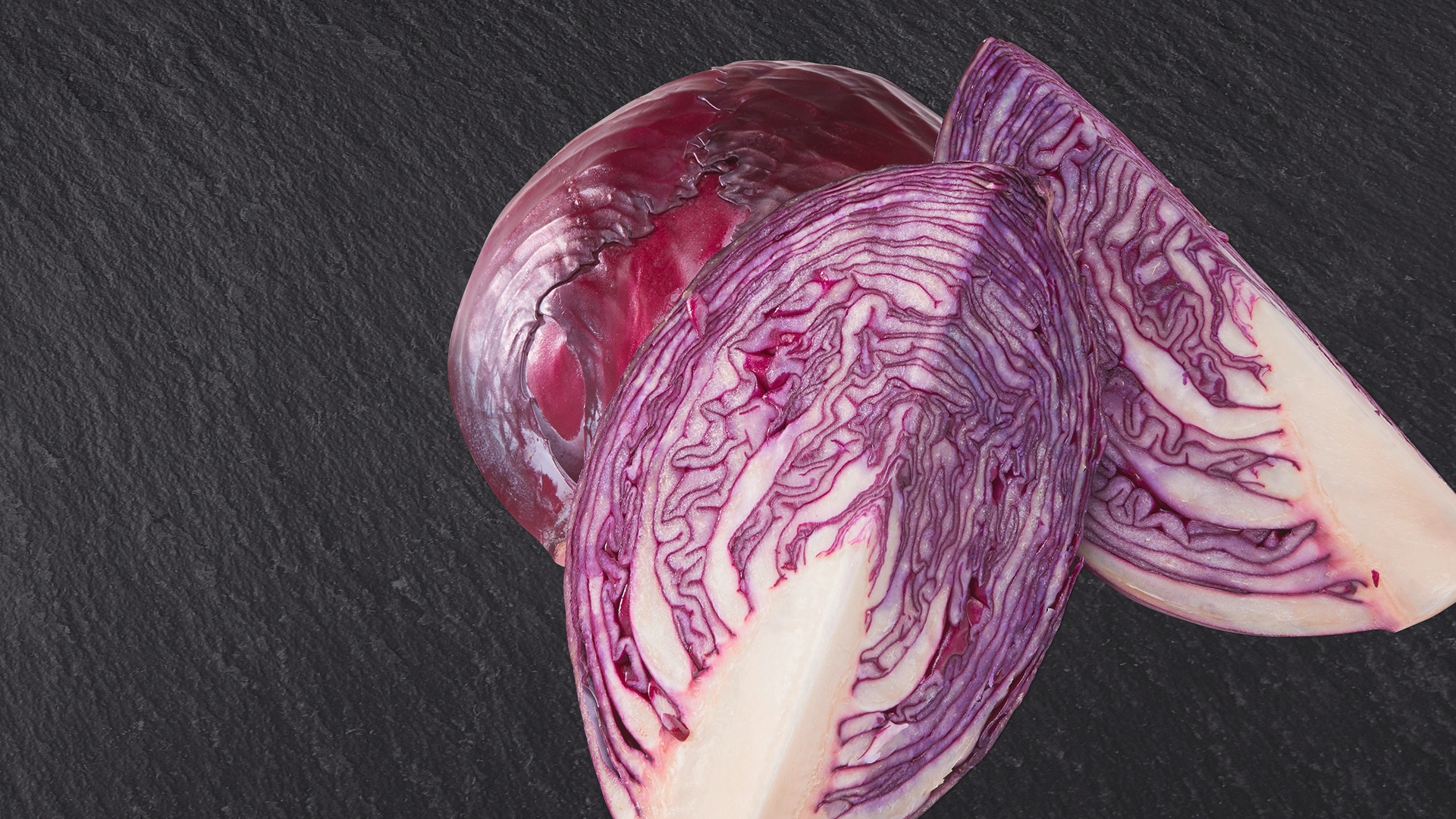Skip to:
Before we delve into red cabbage benefits, you might be wondering what it actually is. As the name suggests, red cabbage (also called purple cabbage) is a type of cabbage with deep red or purple leaves. The colour of the leaves (an indication of its flavonoid-anthocyanin content) changes depending on the acidity of the soil it’s grown in, so it can be more red or purple depending on where it’s harvested. Red cabbage is a cruciferous vegetable from the Brassica (cabbage) family, which also includes broccoli, kale and Brussels sprouts. Eaten raw, it has a slightly peppery taste with a crispy texture. When cooked, it becomes sweeter and tastes more like regular green cabbage.
As well as adding a splash of colour to dishes, red cabbage is also full of nutrients and antioxidants. It is a good source of Vitamin C and Vitamin K. From helping to support a healthy heart to maintaining healthy bones, red cabbage is fantastic for getting more nutrients into your meals. To get the lowdown on red cabbage’s benefits for our health and the planet, plus why it’s one of our Future 50 Foods, keep on reading!
Health Benefits of Red Cabbage
The health benefits of red cabbage aren’t spoken about that much, so you might be surprised by just how nutrient-packed it actually is! Low in calories, red cabbage is jam-packed full of vitamins and minerals. Here are 6 interesting red cabbage nutrition facts that might surprise you…
It boosts immunity
When it comes to Vitamin C, we tend to think of citrus fruits like oranges. However, just 1 cup of red cabbage (89g) as per the USDA provides 56% of the daily value of Vitamin C.
And why is Vitamin C so important, you ask? Well, Vitamin C is a powerful antioxidant, which not only helps boost the immune system but also helps in wound healing, iron absorption and healthy maintenance of bones and cartilage...
It helps with healing
Red cabbage is also a great source of Vitamin K. Not heard of Vitamin K before? Although it’s not spoken about as much, Vitamin K plays an important role in the body for bone health and blood clotting.
Maintains strong bones
As we mentioned earlier, red cabbage contains Vitamin K. Vitamin K is also essential for supporting strong bones. Other nutrients including calcium, magnesium and zinc are also present in small amounts that help with maintaining bone function.
Supports a healthy digestive system
Cabbage is a good source of fibre (soluble and insoluble), which keeps you fuller for longer and can prevent overeating. The fiber can help you keep a healthy gut and adds bulk to the stools, thereby reducing the risk to constipation.
It counts as one of your 5-a-day
Trying to up your fruit and vegetables intake? Just 1 cup of red cabbage can count as 1 of your 5 recommended portions of fruit and veggies a day. Plus, as it can be eaten raw or cooked, there are plenty of different ways to incorporate it into your meals – so you won’t get bored!
Tasty ways to enjoy red cabbage
Now that you know all about the health benefits of red cabbage, you’re probably craving some recipes to try it in. We’ve got you covered. Getting red cabbage into your everyday meals is easy as it’s incredibly versatile. It can be fried, braised, steamed, or even simply added raw to salads or coleslaw.
Red cabbage is also the main ingredient used to make sauerkraut, a traditional fermented dish that’s similar to kimchi. To make sauerkraut, sliced cabbage is layered with salt, stored in an airtight container and left to ferment for at least two weeks. Sauerkraut has a distinctively sour, vinegar-like flavour which compliments salads, soups and fish dishes. It also works great as a side dish.
If you’re looking for mealtime inspiration, check out some of our favourite ideas for how to serve red cabbage:
- Here’s a delicious recipe for fish tacos with cabbage slaw
- Learn how to make a zingy Asian slaw in just 5 minutes
Red cabbage nutritional information
100g of raw red cabbage contains; 31 calories, 1.4g of protein, 7.4g of carbohydrates and 0.16g of fat. Red cabbage is high in immunity-boosting Vitamin C, Vitamin K for maintaining bone health.
Why we should eat more red cabbage
While green cabbage boasts many health benefits, globally we rely too heavily on a select few foods. This puts an intense level of pressure on the planet to meet production demands while also excluding many nutritionally valuable and delicious foods from our diet. By eating more varieties of similar foods, like red cabbage for example, our food system will become more resilient, more diverse and less reliant on specific foods. Furthermore, this will help to increase the planet’s plant diversity and support its natural ecosystems.
Now you know about red cabbage benefits, head over to learn about our other Future 50 Foods and why we think they’re so important for both improving our health and supporting the environment.

